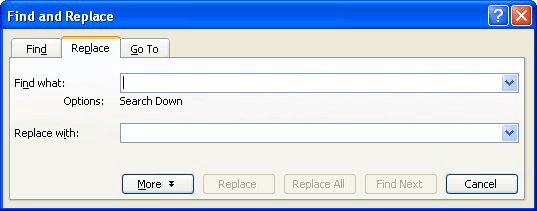Beginning in Word 2000, Microsoft introduced a new character called the no-width optional break. This character has been discussed in other issues of WordTips; for English documents it can be used to wrap long or compound words at non-standard places. For instance, it could be used to add an optional break after a slash character.
If you want to use the no-width optional break in a document that has lots of slashes, you may wonder if there is a way to do a find and replace to add the special character. The short answer is "yes, there is." Follow these steps:

Figure 1. The Replace tab of the Find and Replace dialog box.
Holding down the Alt key as you type 8203 on the numeric keypad inserts the Unicode character for the no-width optional break. After performing all the steps, your document is set to do an optional break after any slash character.
WordTips is your source for cost-effective Microsoft Word training. (Microsoft Word is the most popular word processing software in the world.) This tip (3903) applies to Microsoft Word 2000, 2002, and 2003.

Discover the Power of Microsoft Office This beginner-friendly guide reveals the expert tips and strategies you need to skyrocket your productivity and use Office 365 like a pro. Mastering software like Word, Excel, and PowerPoint is essential to be more efficient and advance your career. Simple lessons guide you through every step, providing the knowledge you need to get started. Check out Microsoft Office 365 For Beginners today!
Find and Replace can work great, but not necessarily for text within text boxes. This tip discusses all the ins and outs ...
Discover MoreSearching for different types of words in your documents is a nice thing to contemplate, but it is much harder to do in ...
Discover MoreNeed to know how many times a particular word appears in a document? Here's a handy trick that will tell you the count, ...
Discover MoreFREE SERVICE: Get tips like this every week in WordTips, a free productivity newsletter. Enter your address and click "Subscribe."
2022-04-23 14:51:48
Phil Rabichow
Strange. I've tried this in Word 2003 & using Alt+8203 on the numeric keyboard & all it does is insert a rectangle within a rectangle.
Got a version of Word that uses the menu interface (Word 97, Word 2000, Word 2002, or Word 2003)? This site is for you! If you use a later version of Word, visit our WordTips site focusing on the ribbon interface.
Visit the WordTips channel on YouTube
FREE SERVICE: Get tips like this every week in WordTips, a free productivity newsletter. Enter your address and click "Subscribe."
Copyright © 2025 Sharon Parq Associates, Inc.
Comments